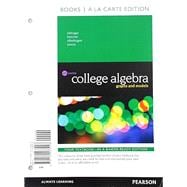NOTE: This edition features the same content as the traditional text in a convenient, three-hole-punched, loose-leaf version. Books a la Carte also offer a great value–this format costs significantly less than a new textbook. Before purchasing, check with your instructor or review your course syllabus to ensure that you select the correct ISBN. Several versions of Pearson's MyLab & Mastering products exist for each title, including customized versions for individual schools, and registrations are not transferable. In addition, you may need a CourseID, provided by your instructor, to register for and use Pearson's MyLab & Mastering products.
For courses in college algebra.
Visualize. Interact. Succeed.
The Graphs and Models series by Bittinger, Beecher, Ellenbogen, and Penna is known for helping students “see the math” through its focus on visualization and technology. These texts continue to maintain the features that have helped students succeed for years: focus on functions, visual emphasis, side-by-side algebraic and graphical solutions, and real-data applications. With the Sixth Edition, visualization is taken to a new level with technology, and students find even more ongoing review.
Also available with MyMathLab
MyMathLab® is an online homework, tutorial, and assessment program designed to work with this text to engage students and improve results. Within its structured environment, students practice what they learn, test their understanding, and pursue a personalized study plan that helps them absorb course material and understand difficult concepts.
New Guided Visualizations in MyMathLab help students allow for hands-on manipulation to gain understanding of difficult concepts. References to 28 Just-In-Time review topics are placed throughout the text and MyMathLab to help students right when they need it most, and new Cumulative Review Assignments and Skill Maintenance Quizzes are pre-made and assignable in MyMathLab to help students connect concepts and maintain skills throughout the course. Plus, new Video Assessment Exercises and a new Video Notebook further enhance the MyMathLab course and resources available.
Note: You are purchasing a standalone product; MyMathLab does not come packaged with this content. Students, if interested in purchasing this title with MyMathLab, ask your instructor for the correct package ISBN and Course ID. Instructors, contact your Pearson representative for more information.










